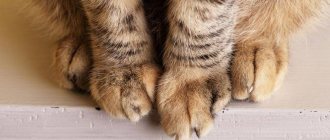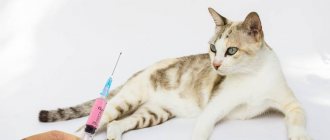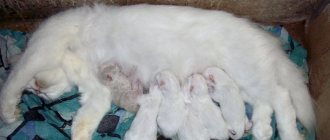Healthy cats are full of activity and appear cheerful. Any disease, even a minor one, always affects the behavior of the animal. An attentive owner will definitely notice alarming symptoms and seek medical help from a veterinary clinic.
- 2 What diseases do cats have
2.1 Video: skin diseases in cats
- 3.1 Table: common cat diseases and their characteristic symptoms
The first signs of disease
It is best not to allow the disease to occur at all, but if this turns out to be impossible and the cat is already developing some kind of pathology, the main thing is to notice the first symptoms - this will help to start treatment in a timely manner. The vast majority of diseases are easiest to treat at the very beginning. But there is a difficulty that prevents you from noticing health problems in time.
Cats, as a rule, try to hide their weakness, even from their beloved owners. This makes sense considering how felines have survived in the wild for millions of years. It was important for a lone predator to look strong and healthy both in front of fellow competitors and in front of potential enemies, so that no one would have the desire to challenge him. Therefore, cats have learned to hide pain or illness from prying eyes.
However, there is still a chance that your purr will let you know that you are not feeling well. If your cat meows frequently and loudly, it may well mean that she is trying to tell you about her illness (but it could also be explained by a hormonal peak - if the animal is not spayed or neutered, or even a simple attempt to attract attention, for example, to play ). Excessive nighttime activity of the pet (running around and/or meowing) may also indicate health problems - but, again, this is only one of the possible reasons.
If there are medical problems, the pet may also show aggression, especially if it touches an area that is bothering you. But sometimes aggression can seem outwardly unmotivated. What all these cases have in common is that the cat is trying with all its might to attract your attention. So if one of these forms of behavior is observed (constant meowing, nocturnal activity, aggression) coupled with at least some of the symptoms listed below, then the cat should be urgently shown to a veterinarian.
Symptoms can be divided into specific and nonspecific. Nonspecific, or general, symptoms accompany all, or at least most, diseases. Specific ones will be observed in a cat if it suffers from a specific disease or ailments associated with a specific system of the body (this includes, for example, diseases of the skin or gastrointestinal tract).
Pyometra
Inflammation of the uterus is the most common disease in unsterilized females. It often happens in adulthood (after 5 years), but in cats of “temperamental” breeds (Siamese, Sphynx) it happens already in the first year of life. Pyometra can be provoked by using hormonal drops that stop sexual desire.
It is important to understand that although the uterus is filled with pus, the disease is not infectious, but hormonal in nature. High levels of estrogen and progesterone lead to cystic changes in the uterus. Contents begin to accumulate in the organ cavity; in the case of a closed form of pyometra, the walls of the uterus can stretch to unimaginable limits, even to the point of rupture. Pyometra causes severe intoxication and sometimes sepsis.
Symptoms appear 1-2 months after estrus:
- extreme thirst and excessive urination;
- refusal of food;
- temperature increase;
- weakness;
- increase in abdominal contours;
- discharge from the genital tract with an unpleasant odor.
In addition to pyometra, postpartum endometritis and frozen pregnancy are distinguished. Surgical treatment: removal of the uterus and ovaries. With timely intervention, most cats recover.
These dangerous diseases can be prevented by routine sterilization of the cat.
Nonspecific (general) symptoms
Nonspecific symptoms in cats one way or another indicate the general poor condition of the animal. These include:
- Increased or decreased body temperature
A cat's normal body temperature is between 37.5 and 39ºC, with young cats closer to the upper limit and older cats closer to the lower limit. If the temperature goes beyond these limits, this is a reason to be wary even in the absence of other symptoms. When determining body temperature, you should not rely entirely on your nose. It is believed that a dry, warm nose in a cat is a sign of fever. However, it can be like this during sleep and even just in case of hot weather. The only guaranteed way to measure your temperature is to use a thermometer. But mercury thermometers are absolutely not suitable for cats (since there is a high probability that the cat will break it); only electronic and rectal thermometers are acceptable. An increased temperature is also indicated by increased breathing and heart rate (the normal cat's heart rate is 100-130 beats per minute), dilated pupils, intense thirst, and warming ears and fur.
— Decreased appetite
An adult (but not elderly) cat can go without food for up to three days, but this is the maximum. Then irreversible processes in the liver begin. Therefore, if the cat does not eat for the third day in a row, urgently take it to the veterinary clinic. In the case of kittens and older cats, this should be done already on the second day.
Of course, it is possible that the cat does not completely refuse food, but his appetite simply decreases. In any case, a sharp decrease in interest in food, weight loss (or, conversely, a sharp gain) should alert the owner.
Read about the reasons for refusing food or water: The cat does not eat or drink - what to do?
- Apathy, lethargy
A clear sign of illness is if a previously playful pet becomes lethargic, weak, does not want to move, and does not respond to the owner’s offer to play (for example, using a “fishing rod”). An even more obvious symptom is if the kitten hides in corners and in different secluded places and begins to be afraid of people. As soon as you notice this behavior, take him to the vet immediately.
Also, nonspecific symptoms of cat diseases include the following (although they are not observed in absolutely all cases):
— Hair problems
This could be hair loss, dullness, or the appearance of bald patches - all this indicates an imbalance in the cat’s body. Sores or peeling may be found on the skin.
— Vomiting and/or diarrhea
- Purulent discharge from the eyes, nose and ears.
How to understand that a cat is sick
A cat can get sick at any age. And also the development of pathologies does not depend on the breed of the animal. If your cat’s health deteriorates, the following general signs may be observed:
- lethargy of the animal;
- poor appetite;
- anxiety;
- sleep disturbance.
If a cat refuses a favorite treat, this should alert the owner
Symptoms of skin and coat diseases
If a cat is regularly outside unattended, then he has a high probability of contracting a skin or fur disease. In most cases, these diseases are caused by parasites: fleas, ticks, lice and lice. Pets are not completely protected from them (they can get into the apartment on the owner’s clothes or shoes), but the risk for them is still insignificant. This is one of the reasons why cats should not be left alone.
Read more about self-walking: Self-walking - when freedom means death
But it is quite easy to notice the symptoms of these diseases in cats. Cats, as a rule, show anxiety and nervousness, scratch a certain area of the body, often lick themselves as if biting themselves, bald spots, bald spots, small black spots appear on the fur, ulcers and various spots appear on the skin.
Allergic reactions
The first symptoms of the disease are dull, brittle hair, the appearance of bald spots and constant scratching of the skin. Allergies can manifest as redness on the skin, peeling and itching. The cause of an allergic reaction can be:
- food intolerance to food components: carefully study the composition of the food and consult a veterinarian;
- contact hypersensitivity: household dust, house plants, detergents and litter for the tray, shampoo and much more;
- hypersensitivity to flea, lice, and tick bites;
- changes in hormonal levels;
- bacterial infections.
Infectious diseases
Infectious diseases are considered the most dangerous and difficult to treat. They, in turn, are divided into viral, bacterial and fungal. These diseases are numerous, have many subtypes, and their symptoms are different. But all are characterized by strongly expressed nonspecific symptoms (high fever, refusal to eat, weakness and apathy, vomiting, diarrhea). Among the specific ones, fever, whitening of the oral mucosa, and runny nose are often encountered. In case of infectious diseases, it is very important to consult an experienced doctor as soon as possible. Sometimes the life of a pet depends on the timeliness of treatment.
It is better not to treat viral diseases, but to prevent them, especially since some of them (for example, rabies) are incurable. But annual vaccination can dramatically reduce unnecessary risks. That's why all adoption wards are vaccinated. Don't risk the life and health of your pets!
Read more: What types of vaccinations are there for cats and why are they needed?
Prevention
To reduce the risk of developing diseases in your beloved pets, follow these recommendations:
- Visit your veterinarian regularly for preventative medical examinations;
- Make sure your cat's diet is balanced;
- do not allow the animal to become obese;
- To prevent worms, do not use raw meat and fish in your cat’s diet. When feeding your animal dry food, pay attention to the expiration date of the food product;
- Do not refuse mandatory vaccinations for cats. For example, you can only protect yourself from rabies through vaccination.
Vaccination will help protect your pet from dangerous diseases.
The outcome of any cat disease primarily depends on the competent actions of the owner: if any pathological signs appear in the animal, you should consult a specialist.
Eye diseases
Symptoms of eye diseases are clearly visible by external signs:
- profuse purulent discharge and lacrimation;
- photophobia;
- swelling and redness of the eyelids;
- clouding of the lens;
- protrusion of the eyeball.
The most common eye diseases in cats are glaucoma, conjunctivitis, cataracts, inflammation and wounds of the cornea. If the problem is not diagnosed and treated in time, the cat may go blind. Do not under any circumstances try to self-medicate with the help of so-called. "folk remedies".
Read more about this: Is treating cats with “folk remedies” effective?
Pancreatitis
Pancreatitis is inflammation of the pancreas, which is responsible for the production of digestive enzymes. Cats can suffer from acute pancreatitis, the exact cause of which is still unclear to veterinarians. Sometimes the provoking factor is fatty foods containing spices or a sudden change in diet. The disease causes severe suffering to the animal and is very dangerous: there is a risk of “self-digestion” of the gland by enzymes and its irreversible destruction.
Symptoms:
- repeated vomiting, including a fountain;
- diarrhea, other stool disorders;
- signs of severe pain, tenderness of the abdominal wall;
- depression, dehydration.
Making a diagnosis can be difficult: a blood test only helps to rule out liver problems. Increased amylase and lipase, contrary to established misconceptions, are not indicative of pancreatitis in cats. Ultrasound allows you to see swelling and enlargement of the pancreas if the study is performed by an experienced specialist. In doubtful cases, a computed tomography is performed.
Sometimes pancreatitis is confused with a foreign body in the intestine due to a similar clinical picture and the ineffectiveness of conservative treatment. Then the condition of the gland is assessed during a diagnostic operation.
Treatment consists of long-term infusion therapy (drips), pain relief (morphine derivatives), the use of antiemetic drugs and a special diet.
Ear diseases
The main problem associated with ears is ear mites. You should be concerned if your cat shakes his head frequently. The formation of a dark brown plaque in the area of the ears is also characteristic. In addition to ear parasites, cats often have otitis media, eczema, and hematomas. Specific symptoms in this case will be: severe itching, irritability of the cat (it will react very aggressively to attempts to touch the sore ear), as well as sulfur, purulent and bloody discharge from the ears.
Character of bowel movements
In order to notice changes in the nature of feces and urine, you need to know what they should be normally in a cat. Feces may vary slightly in consistency and color (depending on the type of feeding). But in any case, feces should be formed, the color should be from light brown to dark brown, without a strong odor.
In sick cats, the stool may be too loose (diarrhea) or too dry (dehydration, constipation), and the color may range from light gray to black. The smell of feces in some diseases can be extremely unpleasant and very pungent.
A cat’s urine should normally be transparent, yellow, with a specific odor, without foreign inclusions (traces of blood, “sand”, etc.).
Diseases of the genitourinary system
Diseases of the genitourinary system, unfortunately, are very common. Most often, their cause lies in an incorrect diet - cheap food, food from the human table (cats and I have different metabolisms, so foods that suit us are harmful to them), etc. Also, these diseases (especially the most common - urolithiasis) are promoted by obesity and a sedentary lifestyle.
Read about food “from the table”: Natural food for cats: benefit or harm?
Specific symptoms include:
- disturbance of normal urination (from frequent to complete absence);
- pain when trying to go to the toilet (manifests, for example, in frequent and loud meows);
- blood in urine;
- strong thirst.
If this disease is neglected, the consequences can be severe, even death.
What pathologies are older cats susceptible to?
Older cats have an increased risk of developing the following diseases:
- diseases of the musculoskeletal system. Metabolism in cats becomes disrupted as they age, which can lead to a decrease in calcium and phosphorus levels in the blood. The lack of these beneficial substances leads to the destruction of bone and cartilage tissue;
- heart pathologies. Elderly cats are often diagnosed with high blood pressure, which can cause problems with the cardiovascular system;
- diabetes mellitus type II. Many older cats don't exercise much and are therefore susceptible to becoming overweight;
- chronic renal failure. As cats age, blood circulation may deteriorate, which often causes a decrease in the excretory capacity of the kidneys.
Old age is an additional factor in the development of diseases in cats
Wounds and injuries
Unfortunately, this is not such a rare occurrence for cats, especially if they are allowed to walk outside. Of course, serious wounds or injuries are difficult to miss, but some - bites, bruises, scratches, cuts - may be more hidden, and they will not only cause discomfort to your pet, but also increase the risk of secondary infection. They can be identified by the following signs: bleeding, changes in gait, limping, purulent discharge in some places, bald spots on the fur, anxiety, reluctance to let the owner near any part of the body. Even if the wound is small, it is better to immediately contact the clinic, since there is no guarantee that the wound has not been infected.
Read more: How to treat wounds on a cat
Conjunctivitis
Inflammation of the mucous membrane of the eyes is very common in cats. The most likely cause is a viral infection or eye injury.
Symptoms:
- redness of the eyes;
- eyes “flow” (large amount of tears);
- squinting, photophobia;
- copious discharge - mucous or purulent.
If such signs appear, the cat should be shown to a veterinary ophthalmologist. First aid at home is to remove the secretions that stick together the eyelids and soak the fur with a damp cotton pad. If injury is suspected (a corneal defect can be visible to the naked eye), human eye drops are used: Floxal or Tobrex 4-6 times a day.
Central nervous system diseases
Diseases of the central nervous system are relatively rare in cats (with the exception of rabies, which, although it affects the nervous system, is still of a viral nature), but they cannot be ignored. The following symptoms will indicate diseases of this group: aggression, changes in habitual behavior (excessive activity is replaced by lethargy and apathy), convulsions, lack of coordination, paresis (partial loss of motor function) and paralysis. Although such pathologies are rare, they are extremely dangerous and must be noticed at an early stage, otherwise the likelihood of death becomes too great.
What are the most common diseases in kittens?
Kittens can also be susceptible to various diseases. However, the most common pathologies observed in children are:
- upper respiratory tract infections;
- worms;
- flea damage to the skin;
- colitis.
To help the kitten, you should not hesitate and seek medical help from a veterinarian.
The immune system of kittens is in the formative stage, so the body’s defenses are weakened. This causes frequent respiratory diseases.
Oncology
It must be said that cats suffer from tumors less often than other pets. However, the tumors that appear in them are usually malignant. Cancer is 3-4 times more common in cats than in dogs. Tumors can arise in almost any tissue of the body. Their presence is signaled by: an unpleasant odor from the mouth, diarrhea, nausea, apathy, constant drowsiness, loss of appetite, sudden lameness, a change in habitual behavior (the animal does not allow itself to be picked up, breaks out, tries to hide), the appearance of lumps under the skin (or growths). on it). As in the previous case, the effectiveness of treatment depends on the stage at which the problem was discovered.
Read more about this: Tumors in cats and their removal
Thus, there are many possible diseases in cats; they affect a variety of body systems. Therefore, only a specialist can make an accurate diagnosis. But there are some common signs that are characteristic of most diseases. If you notice symptoms in a kitten such as fever, refusal to eat, apathy, vomiting, diarrhea, then even in the absence of other signs, urgently take him to the clinic or call a doctor at home.
“Murkosha” also reminds you of the need for routine examinations by a veterinarian: adult pets should be checked at least once a year, elderly pets – 2-3 times a year. If you follow all the recommendations, pay attention to preventive measures, and do not let diseases develop if they do occur, then your pet will be guaranteed a long healthy life!
Contacting a veterinarian
Once you are convinced that a personal consultation with your veterinarian is necessary, schedule an examination and carefully place your pet in the carrier. To minimize stress and discomfort, it is better to get to the clinic by your own car or taxi.
ADVICE!
Bring a sample of vomit and feces with you, and if possible, collect some fresh urine in the container. All this will help in making a diagnosis.
The importance of diagnostics in a clinical setting
To determine the exact cause of the malaise, it is necessary to undergo tests and undergo a series of instrumental studies. They allow you to exclude diseases with similar symptoms, which is completely impossible at home.
Purpose of treatment
Depending on the diagnosis, the veterinarian may offer two treatment options: surgical and conservative. The first option is used in the most severe cases, when medication is not effective.
The main goal of treatment is to eliminate the cause of the disease. If it is an infection, then antibiotics, antivirals and antimycotics are prescribed to destroy the pathogen. All other medications are used to relieve associated symptoms.
IMPORTANT!
Never use medications from your own medicine cabinet. Most of them are toxic to animals.
Care and diet
The patient must be given rest and put on a diet in order to reduce the load on the weakened body. The rest of the recommendations are individual. If dermatological diseases are detected, regular treatment of the affected areas is required, and if the eyes are affected, moisturizing and cleansing the mucous membranes is required.











